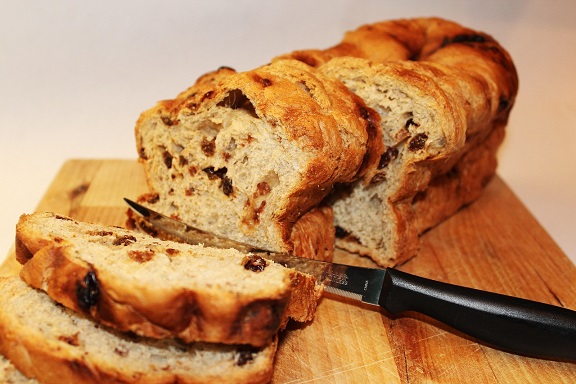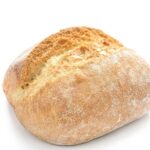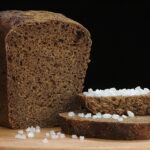
Sweet, soft, and delicately spiced, Rosinenbrot – or German Raisin Bread – is a comforting treat that’s perfect for breakfast, tea time, or a cozy afternoon snack. Made with plump raisins and a tender, enriched dough, it offers subtle sweetness and a nostalgic aroma of home baking.
This golden loaf is a favorite across Germany, especially in bakeries during autumn and around Easter, often served toasted with butter or jam.
The Origins of Rosinenbrot
Raisin bread has long been a part of traditional German home baking. While simple in concept, its enriched dough and dried fruit made it a special occasion bread in earlier centuries. It’s particularly popular in southern Germany, where it’s often shaped into small loaves or braided for holidays.
Today, Rosinenbrot remains a beloved bakery staple, known for its balance of sweetness and rustic charm.
Craving more sweet loaves? Try Früchtebrot – Fruit Bread or Nussbrot – Nut Bread.
Ingredients & Preparation (Step-by-Step Recipe Guide)
Ingredients for Authentic Rosinenbrot Recipe
- 500 g (4 cups) all-purpose flour
- 1 packet (7 g) dry yeast
- 75 g (⅓ cup) sugar
- 1 tsp salt
- 250 ml (1 cup) warm milk
- 80 g (⅓ cup) unsalted butter, softened
- 1 egg
- 150 g (1 cup) raisins
- 1 tsp vanilla extract or lemon zest (optional)
- 1 egg yolk + 1 tbsp milk (for brushing)
Optional tools: Loaf pan, stand mixer, pastry brush, cooling rack
How to Make Rosinenbrot (Step-by-Step Instructions)
Step 1: Soak raisins in warm water or rum for 10–15 minutes. Drain and pat dry.
Step 2: In a bowl, dissolve yeast in warm milk with a pinch of sugar. Let stand 10 minutes until foamy.
Step 3: In a large bowl, combine flour, sugar, salt, and optional zest. Add yeast mixture, egg, and softened butter. Knead into a soft, elastic dough (8–10 minutes).
Step 4: Knead in the raisins gently. Cover and let rise in a warm place for 1–1.5 hours.
Step 5: Shape into a loaf or braid and place in a greased or parchment-lined pan. Let rise another 30–40 minutes.
Step 6: Preheat oven to 180°C (355°F). Brush top with egg yolk and milk.
Step 7: Bake for 35–40 minutes until golden and hollow-sounding when tapped. Cool on a rack.
Tips:
- Add chopped almonds or candied orange peel for variation.
- Best enjoyed slightly warm with a slather of butter.
- Toasts beautifully and keeps well for several days.
Serving Suggestions & Variations
How to Serve Rosinenbrot
Serve with sweet spreads like honey, jam, or nut butter. Makes an excellent base for French toast or bread pudding.
Variations & Regional Twists
- Braided Rosinenzopf: Shape the dough into a braid before baking.
- Almond crust: Sprinkle with sliced almonds before baking.
- Spiced version: Add cinnamon or nutmeg for extra warmth.
You might also enjoy Osterzopf – Easter Braided Bread or Apfelkuchen – Apple Cake for more traditional German baked goods.
Rosinenbrot is the kind of simple pleasure that speaks to the heart – sweet, soft, and infused with the comforting warmth of a traditional home bake. Whether fresh from the oven or toasted the next day, it’s always a treat.
For more authentic German breads, browse our German Bread Recipes collection and take your kitchen back to its roots.







